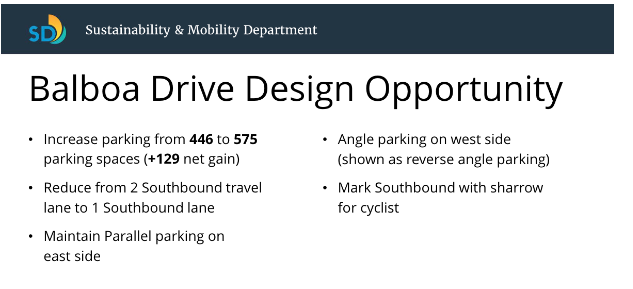Re: Sustainability & Mobility Department’s Balboa Drive Design Opportunities and Next Steps
Background
At the Balboa Park Committee meeting on October 6th, the City’s Sustainability and Mobility Department presented a proposal for redesigning Balboa Drive in Balboa Park.
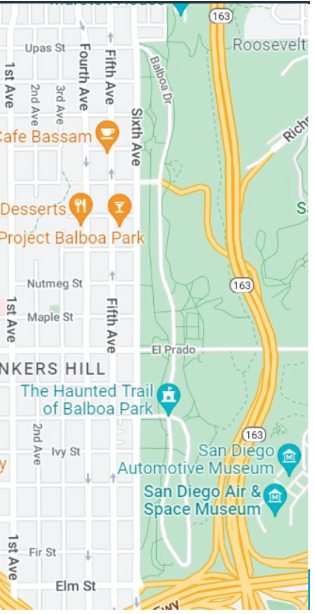
This redesign would align with the upcoming slurry seal project (#2323) which is slated to take place between April – October 2023. The presenters proposed increasing parking for the current 446 spaces to 575 (a nearly 30% increase) to “…offset parking loss on Park Boulevard…”
To provide some context here, the City recently approved a redesign of Park Boulevard, which would remove a general purpose lane and some parking in both directions to make room for bus-only and protected bike lanes. This Park Boulevard reconfiguration, which allows for a safer and more comfortable experience for pedestrians, bicyclists, and transit users, would result in a loss of ~175 parking spaces in a park that has nearly 7,500 free parking spaces – about 2%.
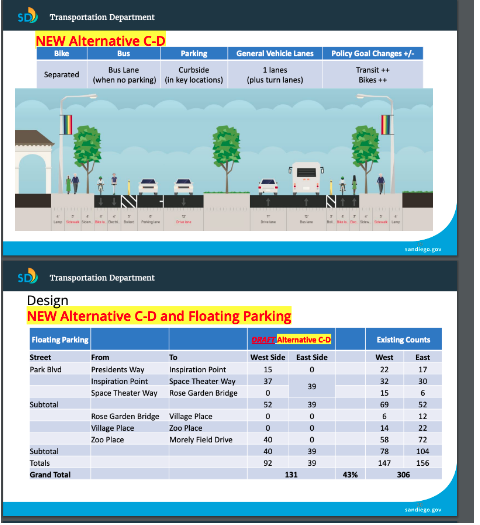
But what does the City decide to do to “offset” this monumental step forward…?
In order to offset this marginal loss of parking, the City has proposed adding more parking elsewhere in the parking, a goal that ignores the City’s own Climate Action Plan.
Worse yet, they propose to do this with angled parking, a redesign that not only further incentivizes automobile travel, but is actually associated with higher rates of collisions than parallel parking.

Problem
Our world is changing — every day we see the consequences of climate change impacting more and more people. In the state of California, thanks to eighty years of urban sprawl, subsidized parking, and an ingrained car culture, over fifty percent of greenhouse gas emissions come from on-road transportation. In an effort to reduce this, San Diego’s ambitious mode shift goals are looking to increase the percentage of bicycling trips to 7% (from 1.4%) and transit trips to 10% (from 4.5%) by 2030.
In parallel, we are facing the crisis of traffic violence: four of the most dangerous metropolitan areas for pedestrians are in California. San Diego has set ambitious Vision Zero goals: aspiring to have zero traffic related fatalities and severe injuries by 2025. Though, the reality, thus far, has looked more like this…
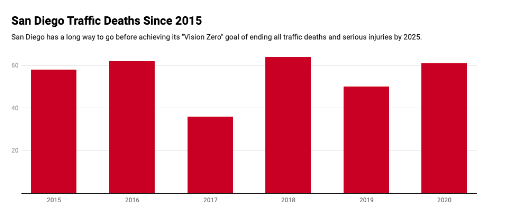
The changes made on Park Boulevard are a brilliant step towards achieving these ambitious goals. It makes biking, transit, and walking more comfortable and will encourage more San Diegans to opt for one of those options when traveling to (or through) our crown jewel.
But we’re adding more parking…?
Adding more parking disincentivizes other ways of transportation to the park, and inherently prioritizes car-based transportation, actively working against the City’s stated goals. The City repeatedly prides itself on the strides made with regards to the Climate Action Plan and Vision Zero, but refuses to accept that adding more parking during a climate emergency is absurd.
We’ve been hearing a lot of talk about climate action and vision zero. Unfortunately, when it comes down to making real, material change in San Diego, we need a dozen meetings to go forward and just one to go back.
Where do we go from here?
Here are the facts:
Balboa Drive is frequently used by bicyclists, families, and dog walkers to traverse the western mesa. We can see this when looking at heatmap data on both Strava and RideWithGPS.
Furthermore, according to the City’s Sustainability and Mobility team, the 446 parking spaces has a ~30% occupancy rate – which means, at any given time, only thirty percent of the parking spaces are utilized. City’s oftentimes plan to add new parking when utilization is above 85% – in this case, it seems like there’s plenty of parking for anyone that might need it
Finally, the 2012 Balboa Park Master Plan explicitly proposes that Balboa Drive (or some path alongside it) serve as a bicycle trail (below). This trail would connect neighborhoods to the Cabrillo Bridge, bowling greens, dog parks, and playgrounds.
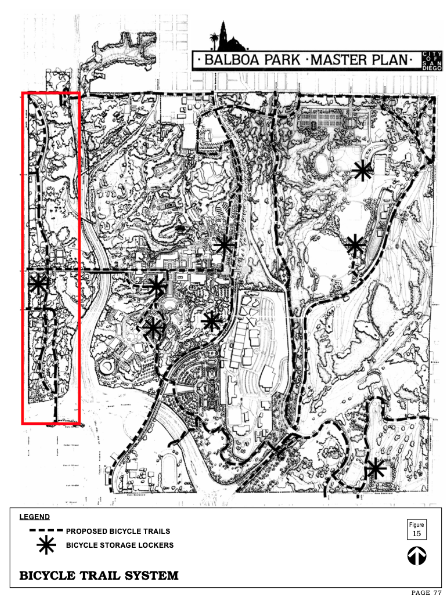
Given all this, here are BikeSD’s recommendations for Balboa Drive’s reconfiguration:
1. Slow down traffic
Reduce Balboa Drive’s width
Reduce the number of vehicle lanes from two to one
2. Enhance active transportation access
Add a bi-directional class IV cycletrack on the east side. This configuration is in line with the City’s “Class IV” first approach
3. Maintain curbside parking on west side
This could be all be completed as part of the next street resurfacing effort and would support:
- 2022 Climate Action Plan goals
- Vision Zero goals
- The Balboa Park Master Plan
We ask the City of San Diego to no longer offset the good it tries to do in one area by doing worse elsewhere. If we absolutely have to optimize parking availability, we recommend that the City set market-rate pricing for parking spots in Balboa Park and use this revenue to make further improvements to our crown jewel (More information here).

